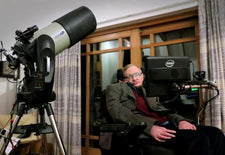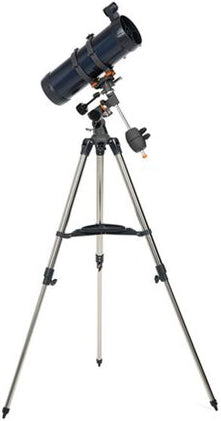Telescope Mounts
May 4, 2015
To a large extent, a telescope is only as good as its tripod and mounting. A telescope magnifies everything, including vibration. That's why many telescopes with decent optics are rendered useless when supplied on a cheaply made mount. The mount's adjustments should be smooth, yet precise, as you'll be using them to track the slow and steady apparent movement of stars. Smooth and precise movements - and a motor drive - are an absolute requirement for astrophotography.
A telescope mount has two functions - (1) Provide a system for smooth controlled movement to point and guide the instrument, and (2) support the telescope firmly so that you can view and photograph objects without having the image disturbed by movement.
There are two major types of mounts for astronomical telescopes: Altazimuth and Equatorial.
Altazimuth - The simplest type of mount with two motions, altitude (up and down/vertical) and azimuth (side to side/horizontal). Altitude and Azimuth - Thus the name Altazimuth . Good altazimuth mounts will have slow-motion knobs to make precise adjustments, which aid in keeping tracking motion smooth. These type mounts are good for terrestrial observing and for scanning the sky at lower power but not for deep sky photography. Certain altazimuth mounts are now computer driven and allow a telescope to track the sky accurately enough for visual use but not for long exposure photography.
Dobsonian Mounts - A newer, modified version of the Altazimuth mount is called the Dobsonian mount. The Dobsonian mount was invented in the 1970's by John Dobson. A Dobsonian mount is mounted on the ground by a heavy platform. A Dobsonian mount was designed to support massively sized Newtonian Reflectors and keep a steady image from the size and weight of the optical tube. It is common for Dobsonian telescopes to have very large apertures - anywhere between 6 and 20+ inches!
Equatorial - Superior to non-computerized altazimuth mounts for astronomical observing over long periods of time and absolutely necessary for astrophotography. As the earth rotates around its axis, the stationary stars appear to move across the sky. If you are observing them using an altazimuth mount, they will quickly float out of view in both axes. A telescope on an equatorial mount can be aimed at a celestial object and easily guided either by manual slow-motion controls or by an electric motor drive to follow the object easily across the sky and keep it in view of the telescope. The equatorial mount is rotated on one axis adjusted to your latitude and that axis is aligned to make it parallel to their Earth's axis, so that if that axis is turned at the same rate of the speed as the Earth, but in the opposite directly, objects will appear to sit still when viewed through the telescope.
There are two basic types of equatorial mounts
German Equatorial Mount - Both Newtonian Reflectors and Refractor telescopes normally use this type mount. A large counterweight extending on the opposite side of the optical tube is its distinguishing feature. The counterweight is needed to balance the weight of the optical tube.
Fork Mount - Most Catadioptric telescopes and other shorter optical tubes use this style mount, which is generally more convenient to use than the German mount, especially for astrophotography. A more recent state-of-the-art computer controlled telescope allows fully automatic operation making it extremely fun and easy to locate objects while saving the observer considerable time and effort.
Unless the telescope is a tabletop model, it should be set on a tripod or pier-type platform. These must be rigid and minimize vibration. They should be portable and lightweight as well as easy to handle and set up. Appearance can be deceiving, as bulk and weight are not as important as a well-engineered tripod or pier.




Now many telescopes feature computerized electronic mounts with features that will automatically located and track objects in the sky. These telescopes automatically take you to thousands of objects in the sky and can even give you a guided tour! For more information see our article on Computerized GoTo Telescopes and GPS Telescopes



